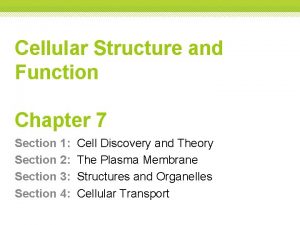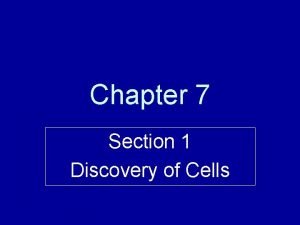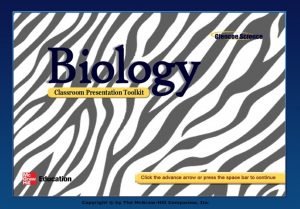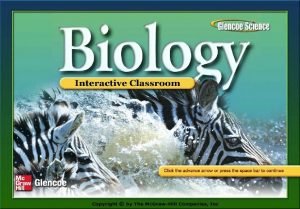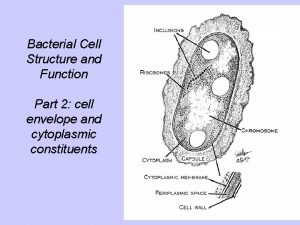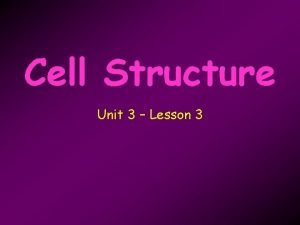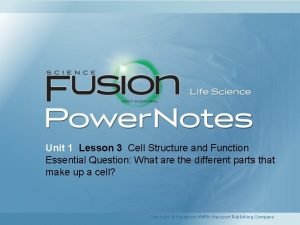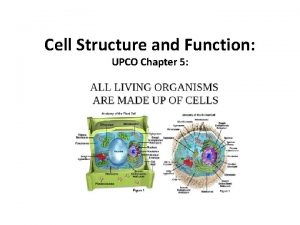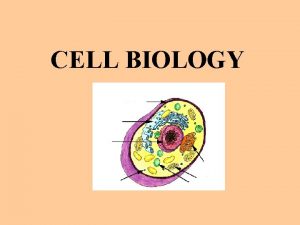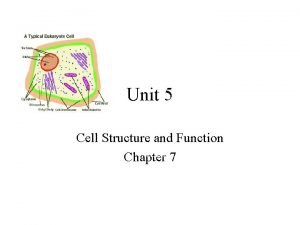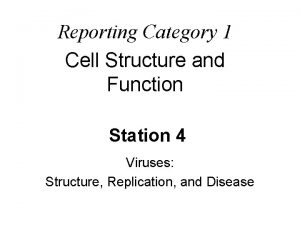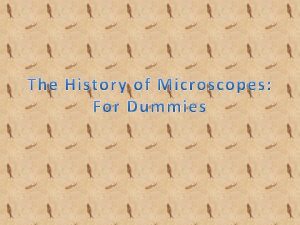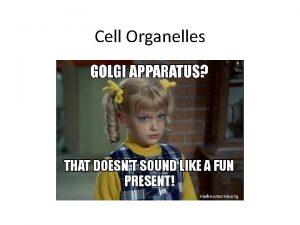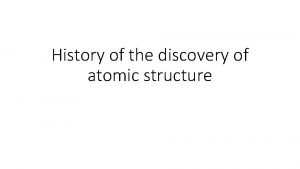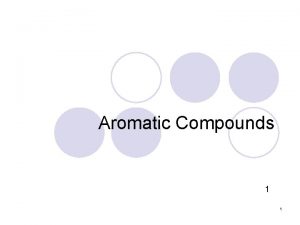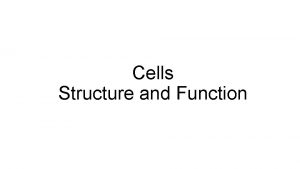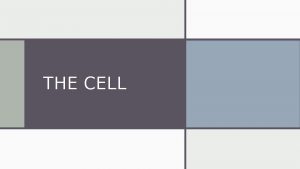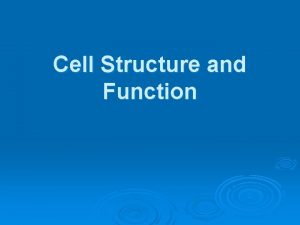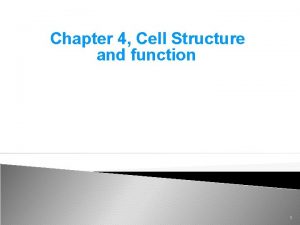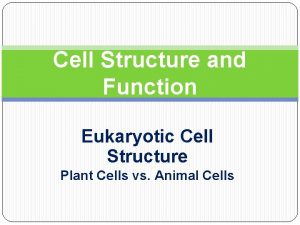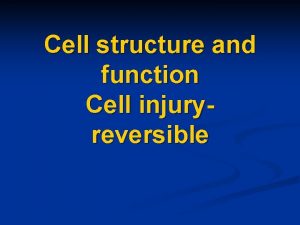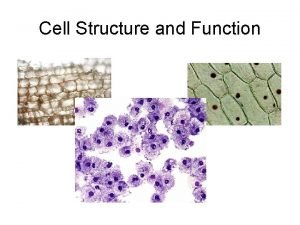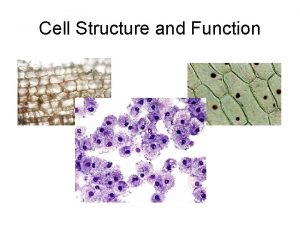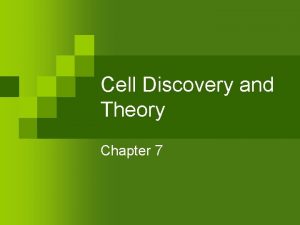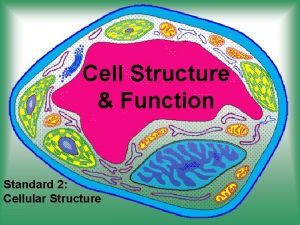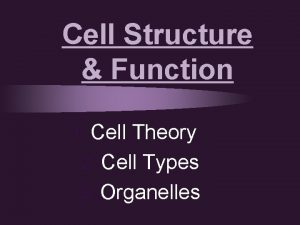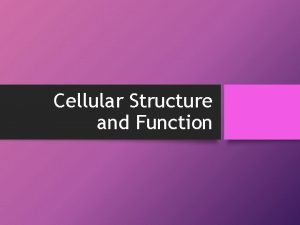Cell Structure and Function Discovery of the Cell























- Slides: 23

Cell Structure and Function

Discovery of the Cell • Robert Hooke, in 1665, coined the term “cell” when viewing a slice of cork under a microscope. The cells referred to what he viewed as empty chambers under a microscope.

What Hooke Saw Under the Scope

Cell Theory 1. All living things are composed of cells. 2. Cells are the basic units of structure and function in living things. 3. New cells are produced from existing cells.

Prokaryotes vs. Eukaryotes • Prokaryotic cells are usually small and simple. They have genetic material that is not contained in a nucleus. They have a cell (or plasma) membrane and ribosomes. Bacteria is an example of a prokaryotic cell. • Eukaryotic cells are large and complex. They have genetic material stored in a nucleus, which separates it from the rest of the cell. Plant and animal cells are examples of eukaryotic cells.

Comparison

Reason for Eukaryotic Complexity • Organelles • These individual structures work together within a eukaryotic cell like departments in a factory. • The organelles are stored throughout the cytoplasm, which is the portion of the cell outside of the nucleus within the cell membrane.

Nucleus • Contains nearly all the eukaryotic cell’s DNA, which are the coded instructions for making proteins and other important molecules. • Protected by the nuclear envelope, which is a double membrane designed to allow flow of materials in and out of the nucleus while protecting the DNA from damage.

Nucleolus • A small, dense region of the nucleus. • This is the location where ribosomes are assembled.

View of Nucleus

Ribosomes • The location where proteins are assembled for the cell. • They take the instructions given from the nucleus and decode them by linking amino acids together in specific orders. • Proteins are essential for life and its reactions.

Endoplasmic Reticulum • The site where lipid components of the cell membrane are assembled. Also where proteins and other materials are assembled for transport out of the cell. Usually located just outside the nucleus of the cell. • Two types, smooth and rough. Rough ER has ribosomes attached to it for the assembly of the proteins to become part of the cell membrane.

View of Ribosome and ER

Golgi Apparatus • Its job is to modify, sort, and package proteins and other materials from the ER for storage in the cell or secretion outside the cell. • Appears in the cell as a stack of closely compacted membranes.

View of Golgi Apparatus

Lysosomes • Small organelle that is filled with digestive enzymes. • Their job is to break down or digest lipids, carbohydrates, and proteins into small molecules that can be used by the rest of the cell. • Often referred to as the cell’s cleanup crew.

View of Lysosome

Vacuoles • Essentially, the cell’s storage containers. • These saclike structures store materials such as water, salts, proteins, and carbohydrates. • In plants, often appears as a large, single central vacuole filled with liquid.

View of Vacuoles

Mitochondria • Powerhouse of the cell. In both plant and animal cells. • Converts the chemical energy stored in food into compounds more convenient for the cell to use. (ATP) • Has an inner and outer membrane.

View of Mitochondria

Chloroplast • In plant cells and some other organisms. • Capture the energy of sunlight and convert it into chemical energy in a process called photosynthesis.

View of Chloroplast
 Chapter 7 section 1 cell discovery and theory
Chapter 7 section 1 cell discovery and theory Chapter 7 section 1 cell discovery and theory
Chapter 7 section 1 cell discovery and theory History of cell
History of cell Section 1 cell discovery and theory
Section 1 cell discovery and theory Bacterial cell structure and function
Bacterial cell structure and function Lesson 3 cell structure and function answer key
Lesson 3 cell structure and function answer key Cell structure and function organizer
Cell structure and function organizer Cytoplasm function
Cytoplasm function What cell is this
What cell is this Eukaryotic cell structure
Eukaryotic cell structure Chapter 7 cell structure and function section review 7-2
Chapter 7 cell structure and function section review 7-2 Eukaryotic cells
Eukaryotic cells Chapter 5 cell structure and function
Chapter 5 cell structure and function Plastids in plant cell
Plastids in plant cell Unit 5 cell structure and function answer key
Unit 5 cell structure and function answer key Category 1 cell structure and function
Category 1 cell structure and function Category 1 cell structure and function
Category 1 cell structure and function Stages of mitosis in onion root tip
Stages of mitosis in onion root tip Robert hooke 1665
Robert hooke 1665 Discovery of cell organelles
Discovery of cell organelles Middle lamella
Middle lamella Discovery of atomic structure
Discovery of atomic structure Benzene structure discovery
Benzene structure discovery Hình ảnh bộ gõ cơ thể búng tay
Hình ảnh bộ gõ cơ thể búng tay
